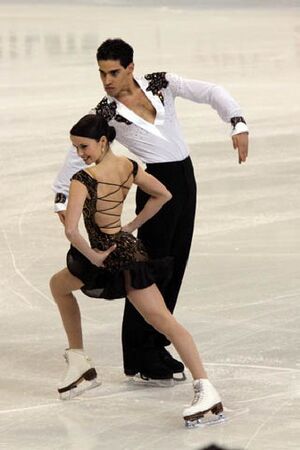Paso doble facts for kids
The Paso doble is a lively dance and a type of music that comes from Spain. It's inspired by the exciting world of Spanish bullfights, especially the grand entrance of the bullfighters. The dance movements copy the proud and dramatic style of the matadors (the bullfighters) in the arena.
Contents
What is the Paso Doble Dance?
In the Paso doble dance, the male dancer plays the part of the matador. The female dancer represents the matador's cape, which is a large, colorful cloth used in bullfighting. It's important to remember she is the cape, not the bull!
How Dancers Move in Paso Doble
The man's posture should be strong and proud, just like a matador. When he has a free arm, he holds it slightly bent, copying the matador's pose. The picture of the ice dancers above shows a great example of the style dancers try to achieve.
Paso Doble as a Ballroom Dance
The Paso doble is one of the five main International Latin ballroom dances. It stands out because its style is very different from the other four dances. Even though it feels very Spanish, the dance steps and techniques were first developed in Paris, France. Later, in the middle of the 20th century, the Latin and American dances, including the Paso doble, became popular in London and took on their modern form.
Understanding Paso Doble Music
Paso doble music is written in 2/4 time, which means it has two beats per measure. It sounds like a march, and the dance itself is a "two-step" (paso doble means "two-step" in Spanish). For dancers, the music is usually played at about 60 to 62 bars (or measures) per minute.
Famous Paso Doble Songs
The most well-known piece of Paso doble music is called España Cañí, which means "Spanish Gypsy Dance." If you listen to a sample of La Gracia de Dios, you can get a good idea of the rhythm and feel of this exciting music.
Images for kids
Learn More
 In Spanish: Pasodoble para niños
In Spanish: Pasodoble para niños




